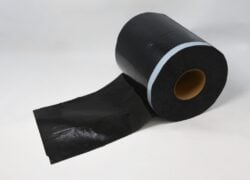Product Data Sheet

| 07 27 13 |
|
AIR-SHIELD™ HT
High Temperature Self-Adhering Membrane
DESCRIPTION
AIR-SHIELD HT high temperature self-adhering membrane is a flexible transition and membrane flashing. It is a roll-type product that is nominally 40 mils thick. The membrane is fabricated from cross-laminated polyethylene film bonded to specially modified asphalt designed to withstand elevated temperatures.
USES
AIR-SHIELD HT high temperature self-adhering membrane is a concealed flashing for masonry concrete, wood/steel frames, and roofing applications – door and window lintels, sills, spandrel beams, caps, and parapets. AIR-SHIELD HT is designed for use as a thru-wall flashing and dampproofing course.
FEATURES/BENEFITS
- Will resist degradation up to 240° F (117° C).
- Controlled thickness membrane is ideal for flashing membrane applications.
- Cross-laminated polyethylene film has excellent tensile strength, elongation, and tear resistant.
- Modified membrane is flexible at low temperatures.
- Rugged membrane can fold to shape during application as a thru-wall flashing.
- Excellent adhesion to prepared substrates of precast concrete, cast-in-place concrete, masonry (concrete block), interior and exterior gypsum board, rigid foam insulation, primed steel, aluminum mill finishes, anodized aluminum, primed galvanized metal, drywall, and plywood.
- Self-sealing characteristics facilitate recovery if minimal damage is sustained under normal use applications.
- No flame required.
- Formulated to withstand elevated temperatures.
PACKAGING
AIR-SHIELD HT is packaged with roll length of 75′ (22.86 m) and is available in widths of 9” (228.6 mm), 12” (304.8 mm), 18” (457.2 mm), and 36” (914.4 mm)
STORAGE
AIR-SHIELD HT should be stored palletized and protected from rain and/or physical damage. Do not store at temperatures above 90º F (32.2º C) for extended periods of time. Do not leave membrane exposed to direct sunlight. Do not double-deck pallets. Store away from sparks or flames. Outdoors, store AIR-SHIELD HT on pallets and completely cover.
TECHNICAL DATA
| Test | Typical Results |
| Thickness: | 40 mils (1 mm) |
| Pliability @ -25° F (-32° C) | No effect |
| Tensile Strength Film ASTM D412 |
5200 psi (35.9 MPa) |
| Elongation Film: ASTM D412 | 200% (Typical) |
| Puncture Resistance: ASTM E154 | 40 lbf (178 N) Min. |
| Water Vapor Permeance ASTM E96, Procedure B |
<0.05 Perms |
| Softening Point ASTM D36 |
242°F (117°C) |
| Water Absorption ASTM D570 |
<0.1% |
| Application Temperature: | 40° F (4° C) Min. and Rising |
| Low Temperature Flexibility @ 10° F (-12° C) CGSB 37-gp-56m |
PASS |
| Service Temperature | -40° to 240° F |
| Lap Peel Strength @ 39° F (4° C) ASTM D903 |
9 lbf/in width (1.58 N/mm) |
APPLICATION
Surface Preparation … All surfaces to receive AIR-SHIELD HT should be clean, dry, smooth, and free from projections that could puncture the membrane. Prepare substrate per manufacturer’s instruction prior to application of membrane. Surfaces shall be free of scale, rust, grease, and oil and conditioned with MEL-PRIME™, MEL-PRIME N.E., or MEL-PRIME W/B from W. R. MEADOWS. All walls to receive AIR-SHIELD HT should be capped to prevent moisture infiltration from entering the wall during construction.
Application Method … Remove release paper prior to application. AIR-SHIELD HT should be recessed a minimum of 1/2” (13 mm) from the face of the masonry. Flashing should not be permanently exposed to sunlight. Do not allow the rubberized asphalt surface of the flashing membrane to contact sealants containing solvents, creosote, uncured coal tar products, EPDM, or PVC components.
AIR-SHIELD HT should either be tied into the wall system or mechanically fastened with TERMINATION BAR from W. R. MEADOWS. If AIR-SHIELD HT is not embedded in the masonry joint, apply TERMINATION BAR at the top edge (and seal with POINTING MASTIC or BEM from W. R. MEADOWS) to mechanically fasten the flashing membrane. Overlaps of the flashing should be a minimum of 2.5” (63.5 mm). Where flashing sections overlap, the seam created by the overlap should be sealed with POINTING MASTIC or BEM from W. R. MEADOWS.
Open Cavity Installation … AIR-SHIELD HT should always be supported across the full width of the wall cavity below. Proper design should provide support with a cavity bridge to ensure AIR-SHIELD HT does not sag in the open cavity and collect water. Adhesion of membrane on oriented strand board (OSB) can sometimes be affected by the level of surface texture or the presence of wax that is part of the binder used to bond together the wood strands. Prior to placement on OSB, in-situ adhesion tests should be performed to determine suitability of substrate prior to full installation. If there are variations in the OSB surface, multiple tests may be required.
Make sure to follow all Masonry Institute of America applications and precautions.
PRECAUTIONS
Intended for concealed and protected applications; not intended for uses subject to abuse or permanent exposure to the elements.
2025-08



 Canada
Canada Français
Français Español
Español International
International



